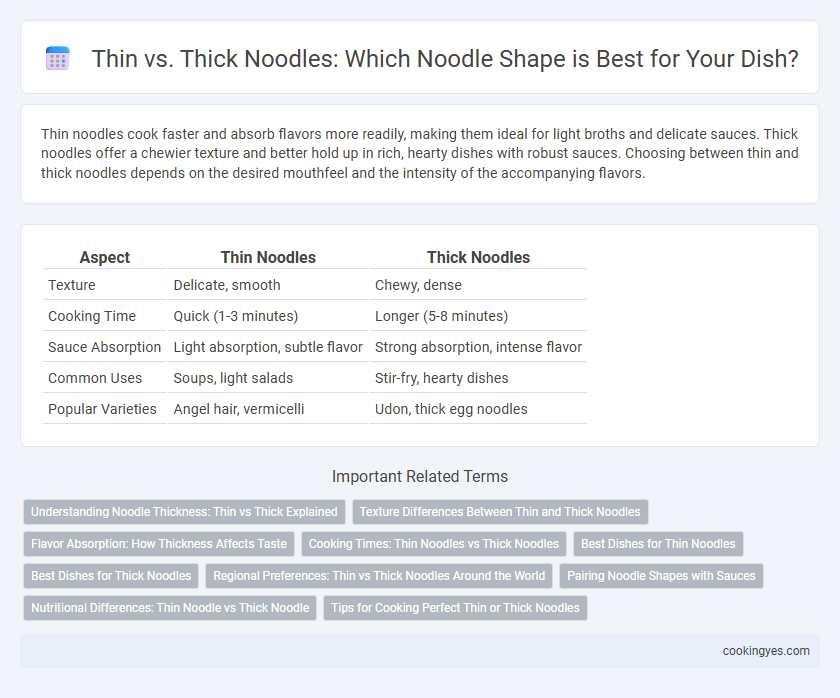Thin noodles cook faster and absorb flavors more readily, making them ideal for light broths and delicate sauces. Thick noodles offer a chewier texture and better hold up in rich, hearty dishes with robust sauces. Choosing between thin and thick noodles depends on the desired mouthfeel and the intensity of the accompanying flavors.
Table of Comparison
| Aspect | Thin Noodles | Thick Noodles |
|---|---|---|
| Texture | Delicate, smooth | Chewy, dense |
| Cooking Time | Quick (1-3 minutes) | Longer (5-8 minutes) |
| Sauce Absorption | Light absorption, subtle flavor | Strong absorption, intense flavor |
| Common Uses | Soups, light salads | Stir-fry, hearty dishes |
| Popular Varieties | Angel hair, vermicelli | Udon, thick egg noodles |
Understanding Noodle Thickness: Thin vs Thick Explained
Noodle thickness significantly affects texture and cooking time, with thin noodles offering a delicate bite and faster cooking, often favored in soups and light dishes. Thick noodles provide a chewier texture and hold up well in hearty sauces and stir-fries, enhancing the overall mouthfeel. Understanding the difference between thin and thick noodles helps in selecting the right type to complement specific recipes and flavor profiles.
Texture Differences Between Thin and Thick Noodles
Thin noodles have a delicate texture, cooking quickly with a light, tender bite that absorbs sauces effortlessly, enhancing subtle flavors. Thick noodles offer a chewier and more substantial mouthfeel, retaining firmness even when well-cooked and providing a hearty base for rich, robust sauces. The choice between thin and thick noodles significantly impacts culinary texture, influencing the overall dining experience with varied bite resilience and sauce absorption properties.
Flavor Absorption: How Thickness Affects Taste
Thinner noodles absorb sauces and broth more effectively due to their larger surface area relative to volume, enhancing the overall flavor experience. Thicker noodles retain more of their own texture and taste, offering a heartier bite that balances richness with subtle sauce infusion. Choosing noodle thickness influences how intensely flavors penetrate, directly impacting the dish's taste profile.
Cooking Times: Thin Noodles vs Thick Noodles
Thin noodles cook significantly faster than thick noodles due to their smaller cross-sectional area, often requiring just 2-3 minutes to reach the desired tenderness. Thick noodles demand longer boiling times, typically 7-10 minutes or more, to ensure they are fully cooked and chewy without being mushy. Adjusting cooking time based on noodle thickness is crucial to achieving optimal texture and flavor in various dishes.
Best Dishes for Thin Noodles
Thin noodles excel in dishes requiring quick cooking and delicate texture, making them perfect for soups like Pho and light stir-fries such as Pad Thai. Their slender shape allows for better coating with subtle sauces and quick absorption of broths, enhancing flavor without overpowering the dish. Thin noodles are ideal in recipes where a tender, smooth bite complements fresh ingredients and aromatic herbs.
Best Dishes for Thick Noodles
Thick noodles excel in hearty dishes like ramen, udon, and chow mein due to their ability to absorb rich broths and sauces, delivering a satisfying, chewy texture that complements robust flavors. Their substantial size makes them ideal for stir-fries and stews where they hold up well against intense cooking methods without losing integrity. Thick noodles are perfect for dishes requiring a pronounced noodle presence, enhancing the overall mouthfeel and flavor intensity in each bite.
Regional Preferences: Thin vs Thick Noodles Around the World
Regional preferences for noodle thickness vary widely, with East Asian cuisines such as Japanese and Vietnamese favoring thin noodles like soba and pho for their delicate texture and quick cooking time. In contrast, Italian and some Chinese regions prefer thick noodles, such as fettuccine and hand-pulled noodles, valued for their chewy bite and ability to hold hearty sauces. These preferences are influenced by local ingredients, traditional cooking methods, and the desired mouthfeel in native dishes.
Pairing Noodle Shapes with Sauces
Thin noodles excel at absorbing light sauces like soy or sesame-based dressings, enhancing delicate flavors without overwhelming the dish. Thick noodles, such as udon or pappardelle, pair best with rich, heavy sauces like cream, meat ragu, or thick tomato-based blends due to their substantial texture and ability to hold robust coatings. Matching noodle thickness to sauce consistency ensures balanced taste and optimal mouthfeel in every bite.
Nutritional Differences: Thin Noodle vs Thick Noodle
Thin noodles typically have a lower glycemic index compared to thick noodles, resulting in slower sugar absorption and better blood sugar control. Thick noodles often contain more calories and carbohydrates per serving due to their density and size, impacting overall energy intake. Both noodle types provide essential carbohydrates, but choosing thin noodles may benefit those monitoring calorie intake or seeking improved digestion.
Tips for Cooking Perfect Thin or Thick Noodles
Thin noodles cook quickly and require constant attention to prevent overcooking, making it essential to use high heat and stir gently. Thick noodles benefit from longer boiling times and slow, even cooking to ensure a chewy texture without becoming mushy. Adjust seasoning and sauce pairing according to noodle thickness for optimal texture and flavor balance.
Thin vs Thick for noodle shape Infographic

 cookingyes.com
cookingyes.com